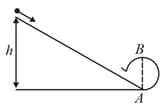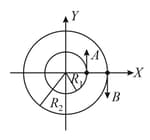A body initially at rest and sliding along a frictionless track from a height (as shown in the figure) Just completes a vertical circle of diameter . The height is equal to



Important Questions on Circular Motion
A point moves in counter-clockwise direction on a circular path as shown in the figure. The movement of '' is such that it sweeps out a length , where is in metres and is in seconds. The radius of the path is . The acceleration of 'P' when is nearly-

Two particles are moving on two concentric circles of radii and with equal angular speed . At , their positions and direction of motion are shown in the figure.

The relative velocity at is
Three point particles , and move in a circle of the radius with different but constant speeds. They start moving at from their initial positions as shown in the figure. The angular velocities (in ) of , and are , and , respectively, in the same sense. The time interval after which they all meet is

